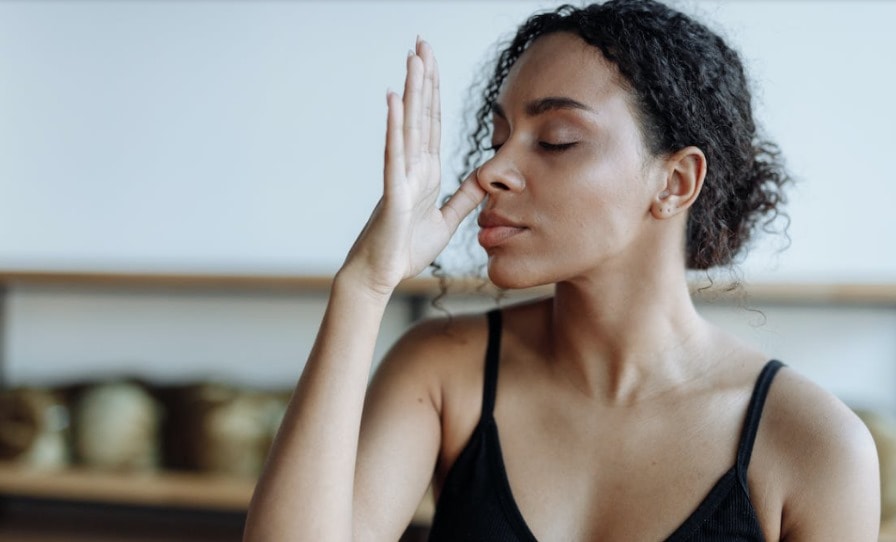Inhale, exhale, repeat!
Everyone on earth does this throughout their lives, and in most cases, we are hardly aware of our breathing cycle.
Yet, simply taking in air and letting it out can improve our lives if we do it a little more consciously.
In this article, we look at eight breathing techniques that can bring about various improvements, from stress relief to better sleep and everything in between.
Keep reading to discover which breathing cycle or technique works best for what you hope to achieve with breathwork.
Importance of Breathwork
There is nothing wrong with breathing at your normal pace; after all, breathing is automatic for a reason ― it keeps you alive whether or not you are aware of the process.
Nevertheless, if you struggle with stress, anxiety, sleep, or lung conditions, you may want to become more aware of your breathing cycle and take charge of the process for at least several minutes daily.
Why is that?
Breathing deeply and slowly can positively affect the central nervous system, helping to reduce stress.
A 2017 study found that voluntarily slowing down your breathing cycle encourages the body to relax, offering plenty of physical and mental health benefits.
For starters, controlled breathing is highly beneficial for preventing the overstimulation of the sympathetic nervous system (SNS), which is responsible for the fight-or-flight response.
The SNS is an important self-preservation mechanism; it boosts the heart rate, improves blood and oxygen delivery, and stimulates other body parts necessary to get you out of danger.
Unfortunately, how we perceive many everyday situations can trigger the SNS, even though we are not in any real and immediate danger. And keeping your SNS in a continuously active state can take a toll on your physical and mental health.
Here’s the rub.
Many people overstimulate their SNS even without knowing.
Taking continuous shallow breaths can activate the SNS. This is especially true when you are always exposed to stress-inducing situations and have little time to practice relaxation exercises like meditation or mindful breathing.
The good news is that deep, controlled breathing can activate the parasympathetic nervous system (PSN), which puts the body in a calm state. This is why you should create time for breathwork as part of your daily routine.
Choosing a Breathing Cycle: 8 Breathing Techniques to Try

Depending on your goal, the following breathing techniques can help ease stress, reduce anxiety, and help you sleep better by promoting relaxation.
It is also possible to get relief from lung conditions with a few of these breathing exercises.
Keep in mind that it may take a while to see appreciable results with some breathing techniques, while others tend to provide immediate relief.
1. Deep Breathing
Try deep breathing whenever you find yourself in a stressful situation. Inhaling slowly and deeply slows your heart rate and helps you feel calmer.
How to do deep breathing exercises:
- Sit in a comfortable position, ensuring to relax your shoulders
- Slowly draw in air through your nose to fill your lungs
- Slowly release the air through your mouth, taking as long as possible to completely empty your lungs
- Repeat until you feel calmer
2. Diaphragmatic Breathing
Diaphragmatic or belly breathing is useful for strengthening the lungs and reducing blood pressure. It is also a good way to improve relaxation.
By engaging the diaphragm, belly breathing reduces the energy and effort you use to breathe and reduces your body’s demand for oxygen.
How to do the diaphragmatic breathing exercise:
- Lie on your back on a bed or any flat surface
- Place one hand on your belly and the other on your chest
- Slowly inhale through your nose to fill your belly. While keeping the hand on your chest still, let the hand on your belly rise as the air fill your diaphragm
- Hold your breath for about two counts
- Gently exhale through your mouth for about six counts
- Repeat for up to 10 minutes
3. Mindful Breathing
Commit to practicing mindful breathing if you have sleep issues. Over time, you will notice a significant improvement in your sleep quality. You can also use this technique to boost your mood.
A simple way to use this breathing technique is to focus on the rhythm of your breath without trying to change it. This will naturally slow down your breathing and heart rate, which can help with better sleep.
How to do mindful breathing exercises:
- Sit or lie down in a comfortable position. Close your eyes if you wish
- Tune in to the natural rhythm of your breath, paying attention to how your body draws in air and releases it
- Allow thoughts to come and go without judgment
- Do this for about five minutes
4. Pursed Lip Breathing
Consider including the pursed lip breathing exercise into your daily routine if you want to improve a lung condition like asthma, pulmonary fibrosis, or chronic obstructive pulmonary disease (COPD).
How to do the pursed lip breathing exercise:
- Slowly inhale through the nose
- Purse your lips as you exhale through your mouth, making sure the exhale is twice as long as the inhale
5. 4-7-8 Breathing
The 4-7-8 breathing technique can aid sleep, making bedtime a good time to do it.
Essentially, this relaxation technique involves inhaling for a count of four, holding your breath for seven counts, and exhaling for a count of eight.
How to do the 4-7-8 breathing exercises:
- Rest the tip of your tongue against the roof of your mouth throughout the exercise
- Exhale completely through the mouth
- Inhale through the nose for a count of four
- Hold your breath for seven counts
- Slightly part your lips and exhale loudly through your mouth for a count of eight
- Repeat the exercise three times
6. Alternate Nostril Breathing
Alternate nostril breathing is popular with yoga practitioners because of its inner balance and channel-cleaning benefits.
And even if yoga isn’t really your thing, this breathing technique is great for relieving stress, sharpening focus, improving breathing, and leaving you feeling invigorated.
How to do the alternate nostril breathing exercise:
- Sit comfortably and exhale completely
- Use your thumb to close your right nostril and breathe in through the left nostril
- With your index finger, close your left nostril and hold your breath for one or two counts
- Remove your thumb from the right nostril and breathe out while still closing the left nostril
- Pause at the end of the exhale and inhale through the right nostril
- Close your right nostril and hold your breath for one or two counts
- Remove your index finger from your left nostril and breathe out
- Repeat the exercise for about five minutes
7. Box Breathing
Looking to improve concentration or re-center yourself? Box breathing can help you achieve that.
The technique distracts your mind by placing your attention on breathing and counting. This way, your mind achieves calmness, your breathing rhythm is relaxed, and your focus is improved.
How to do the box breathing exercise:
- Sit comfortably with your back upright and your palm resting on your lap
- Slowly inhale through your nose, counting to four
- Hold your breath for a count of four
- Slowly exhale through your mouth for a count of four
- Wait for another count of four and repeat the breathing pattern
8. Lion’s Breath
The lion’s breath is an excellent breathwork for immediate relief if you want to release tension, overcome inhibition, manage difficult emotions, or clear your throat chakra.
This breathing technique can feel a bit out there for some people, especially those who tend to be shy. That’s because it involves making a potentially loud “ha” sound while assuming a roaring lion’s pose.
To achieve maximum effect with this exercise, find a private place where you can give this exercise your all without being self-conscious.
How to do the lion’s breath exercise:
- Sit in a chair or on the floor with your legs crossed. You can stand if you prefer
- Slightly move your upper body forward and open your eyes wide, fixing your gaze upward
- Take a deep breath through the nose
- Open your mouth wide and stick out your tongue, curling it down toward your chin
- Breathe out forcefully, making a “ha” sound like a roaring lion
- Take a few normal breaths as you relax your face before repeating the breathing exercise three to five times
- End the respiratory cycle and exercise with about three minutes of normal breathing through the nose
Final Thoughts
Breathing exercises can offer many benefits, including reducing stress and anxious thoughts. They can boost your sense of calmness and improve mental health, and with that, sleeping becomes a bit easier.
Breathwork works!
But you must be consistent to see positive results. Whichever breathing cycle you choose, make it part of your daily routine. That’s how to get the most out of breathing exercises.

